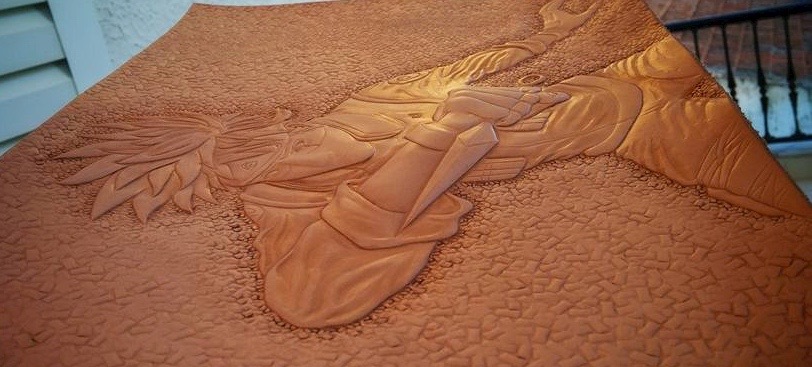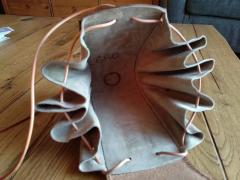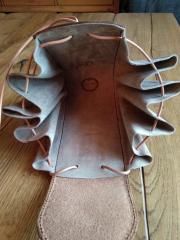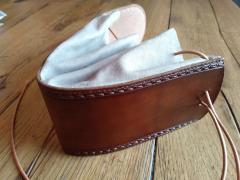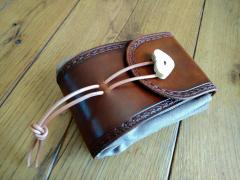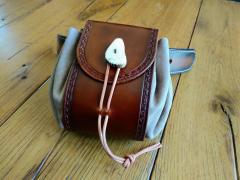-
Posts
2,372 -
Joined
-
Last visited
Content Type
Profiles
Forums
Events
Blogs
Gallery
Everything posted by immiketoo
-
-

'stiffening' soft leather for cutting..
immiketoo replied to canonitr's topic in Leatherwork Conversation
If you get a thick straight edge, like a meter long aluminum one, you can clamp it down in a few spots before cutting. PITA but works every time for straight cuts. -
A properly refurbished one from years past will do those straps with ease. Deals are great, but only if you get exactly what you want. Good man!
-
Just so we’re clear, there is no oil in oil/pro dye. According to the Fiebings rep I spoke with a few years ago the only difference between the two dyes is the quality of the pigment. You’ll get a lot less excess dyestuffs on the surface of the leather, hence the more even color, but both are alcohol based dyes. The chemical composition is identical. MSDS will show this as well. Its is an urban myth among leather workers that oil dye has an oil base. This is simply not true and it is specifically why Fiebings changed the name to pro dye. youre experience may differ, can’t say why that is, but it’s not because of any oil content in the dye. Hope this helps.
-
Hey, Iris. So, pro dye wont work any differently in regards to stiffness, but you will see a noticeable improvement in evenness of coverage, depending on how you're applying it. I think that if you're making the leather stiff, you're applying it too heavily. This is a very common occurrence with dip dyeing and heavy application with a dauber. Its better to sneak up on your color with a few lighter applications than one heavy one. Easier to control and more even results. BTW, blue is one of the most difficult colors to use, apart form purple which is the worst. As for oil, there is a great debate on whether or not its needed. Personally, I don't think it is. Maybe for saddles and horse tack, but for most things its simply not needed. People slap that crap all over their projects and then wonder why it looks dark or splotchy. However, I DO oil lightly between coats of dye when I use an airbrush because it helps set the previous color and helps the new layer absorb better. Buddy of mine gave me that tip and it works great on fades. Airbrush can be very topical and anything to make it sink in more helps. The type of alcohol you use to thin your dye can affect stiffness, so I recommend denatured alcohol. That's what is in the dyes, and its the best for the pigment as well. Other kinds will work but your mileage may vary. Lastly, the type and thickness of the leather makes a difference as well. Thin leather will get crispy pretty easily while thicker leather maintains its suppleness longer. The alcohol in the dye affects the fillers in the leather, fats, collagen etc., so the thinner the leather, the lighter the coat should be. If you can't avoid saturating the leather, replacing some of the suppleness with oil will help, but you must account for the change in color when you dye or it will be darker than you intended during dyeing. My suggestion is to look at the method you use to apply it and experiment with others until you find what works best for you.
-
The only way to do it is to pick the darkest piece and then match to that. I'd start by stripping the finish with deglaze, then airbrushing walnut dye diluted 50/50 with denatured alcohol on a discreet area of the armor until you got close to the piece you selected to match. Don't math it exactly or it will be too dark when you add the finish. It may take some trial and error on pieces that can't be seen. You might also need to use a different color for different pieces. Ultimately, dark colors like chocolate and black may be your only options for making everything look the same. Good luck.
-
-
Welcome to the madness!
-
If I were you, I would wait until you can afford a better model. There are so many options out there that if you don't need it, why get one form Tandy. I'd look at an old Osborne or the like thats been refurbished. You'll be much happier in the long run. Brucejohnsontools.com usually has a great selection.
-
This is true, but it's a lot better than buying it all during the marriage. I'd burn it before I'd let it go. Lawyers suck.
-


